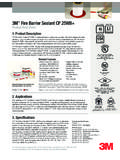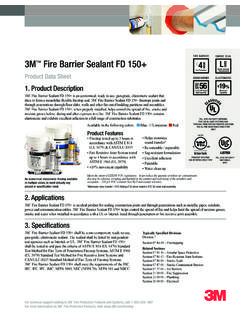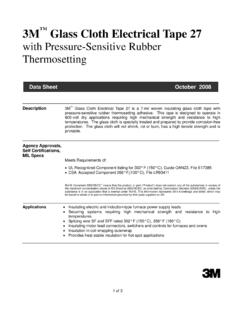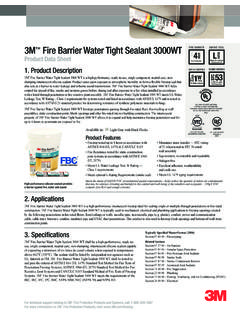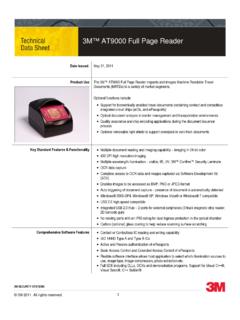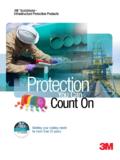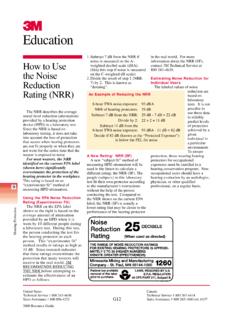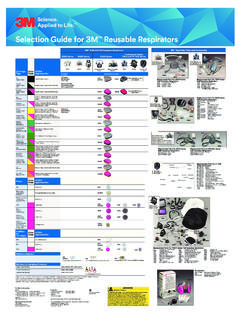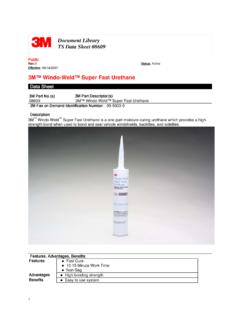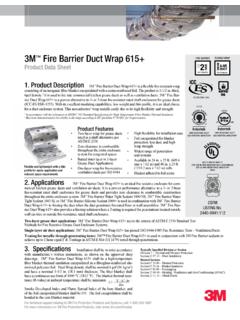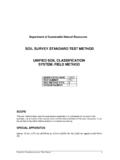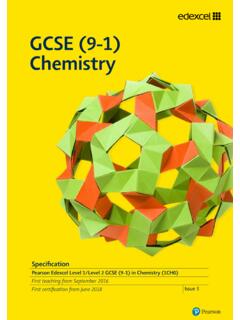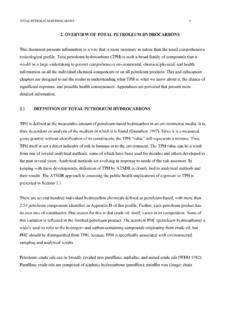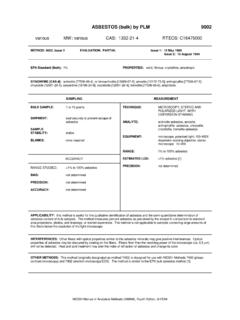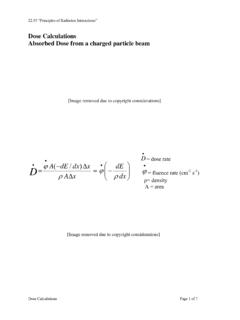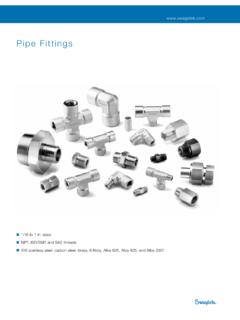Transcription of Respirator Filter Selection Guide
1 Respirator Filter Selection Guide Introduction The information in this Guide is correct as at April 2013, and should be used in conjunction with general occupational hygiene knowledge. The actual workplace conditions will vary from one worksite to another. This information is intended only as a Guide . Selection of the most appropriate RPE will depend on the particular situation and should be made only by a competent person familiar with the working conditions and limitations of RPE. If you have any questions relating to the proper Selection and use of 3M respirators, or the use of this Guide , contact your local 3M OH&ES representative or call the 3M Health and Safety Helpline on 0870 60 800 60 in the UK, or 1800 320 500 in Ireland. Respiratory Protective Equipment Selection This Respirator Filter Selection Guide provides information on the appropriate 3M Filters to be used when using 3M Negative Pressure and Powered Air respirators for nearly 700 chemicals.
2 The Guide also includes Workplace Exposure Limits (WELs) for these substances, a brief summary of their acute effects, and if the 3M Monitor badges may be used to determine personal exposures. Selection of RPE: Risk Assessment Before selecting RPE, a full risk assessment must be performed. If the risk assessment concludes that control of personal exposure is inadequate, employers must introduce preventative or control measures. If control of exposure is still deemed inadequate after the measures have been introduced, RPE may be used as the last resort. If the risk assessment recommends RPE to be worn, and once the workplace contaminants and their concentrations have been identified, this Guide can be used to help select appropriate 3M Filters for use with 3M Negative Pressure and Powered Air respirators.
3 RESPIRATORY PROTECTIVE EQUIPMENT PROGRAMME Four Step Guide Before selecting Respiratory Protective Equipment (RPE), a full risk assessment must be carried out in accordance with the relevant health and safety legislation. Where respirators are used in the workplace, a formal RPE programme should be implemented. It should include: Identification of the hazard and risk assessment. Education and training must be properly emphasised and conducted. Maintenance, cleaning and storage programmes must be established and routinely followed for reusable respirators. The whole programme must also be reviewed at regular intervals. To correctly select RPE four basic steps should be followed: 1. Identify the potential hazard. Before any Selection of respiratory protective equipment can be made, it is important to identify the hazard against which you wish to protect.
4 These hazards can be divided into dusts, mists, fumes, gases and vapours. Consideration may need to be given to oxygen deficiency and even extremes of temperature. No Respirator is ideal for all these types of hazard. For example, respirators fitted with dust filters will not protect against gases or vapours and gas/vapour filters will not protect against dusts. 2. Understand and assess the contaminant s potential health effects. Once the material against which you wish to provide protection has been identified, it is important to understand how that contaminant may affect your body. This information forms a vital part of the training the users receive and allows them to understand why they should wear the equipment provided. Also assess the level of contaminant in the workplace versus its Workplace Exposure Limit (WEL).
5 3. Select the appropriate Respiratory Protective Equipment (RPE). The RPE comes in a wide variety of types, each suitable for a particular range of applications. Although the type of application of certain RPE may overlap, no Respirator is ideal for all applications and care should be taken to understand the limitations of any Respirator before Selection . The Respirator selected must be correct for the work, the environment and the wearer, and not interfere with other PPE. 4. Train the employees in the use and care of the Respirator . Once the Respirator has been correctly selected for a hazard, the application and the individual wearer, it is essential to train the wearer in the correct fitting, use, maintenance and care of the Respirator . It is also important to demonstrate the fitting of the Respirator and how to conduct a face fit check.
6 A Face Fit test should be performed on wearers of respirators with tight fitting facepieces disposable respirators and reusable half or full face masks. Selection OF THE APPROPRIATE TYPE OF RPE The nature of the hazard will determine the type of RPE chosen. RPE is designed specifically to deal with particular hazards, or a combination of hazards. Dust respirators provide no protection from the effects of solvent vapour just as a vapour Respirator provides no respiratory protection against dusts. It is therefore essential that the RPE is correctly selected as a result of an accurate assessment. Summary of the types of RPE There are many types of RPE, but these can be broadly categorised into two types, 1) Air-filtering and 2) Air-supplying equipment. 1. Air-filtering Equipment Equipment which takes in air from the work area and filters or cleans it before it is inhaled.
7 These devices are referred to as air-filtering devices and rely on lung power (negative pressure Respirator ) or an external power source to draw contaminated air through a Filter providing clean air to the breathing zone (powered air respirators). 2. Air-Supplying Equipment Equipment which delivers uncontaminated air from an independent source to the wearer. Gas and Vapour Negative Pressure Respirator Filters Type A: For use against certain organic gases and vapours with a boiling point higher than 65 C as specified by the manufacturer. A filters, whatever the class, are required to be marked with at least the Filter type, the colour code Brown together with the Filter class, , A2. Type B: For use against certain inorganic gases and vapours as specified by the manufacturer (excluding CO). B filters, whatever the class, are required to be marked with at least the Filter type, the colour code Grey together with the Filter class, , B1 Type E: For use against sulphur dioxide and other acidic gases and vapours as specified by the manufacturer.
8 E filters, whatever the class, are required to be marked with at least the Filter type, the colour code Yellow together with the Filter class, , E1 Type K: For use against ammonia and organic ammonia derivatives as specified by the manufacturer. K filters, whatever the class, are required to be marked with at least the Filter type, the colour code Green, together with the Filter class, , K2. Type Hg-P3: For use against mercury. The Filter incorporates a particulate Filter . The Filter must be marked with at least the Filter type, the colour code Red-White, together with the Filter class, , Hg-P3. AX filters are for use against certain low boiling organic compounds. They are classified as in only one type and class, AX. Combined filters for use against certain low boiling organic compounds, as specified by the manufacturer, and particles are classified according to their particle efficiency: Types AXP1, AXP2 and AXP3.
9 AX filters should only be fitted to the 3M full face masks. There is no AX Filter available for 3M Powered Respirators. AX filters must be marked with at least the Filter type, the colour code Brown together with the Filter class. AXP3 filters are colour coded Brown-White. Filter Combinations If a Filter is a combination of types, it shall meet the requirements of each type separately. The Filter must also be marked with at least the Filter type, and with each colour code. For example an ABEK2P3 Filter will be marked, Brown, Grey, Yellow, Green and White. Respirator CHARACTERISTICS, CAPABILITIES & LIMITATIONS Limitations of RPE A Respirator may not be able to protect against all of the contaminants present in a particular work environment. Specific limitations are stated on the packaging and are included with use instructions and limitations.
10 These must be carefully reviewed for each Respirator before use. General precautionary information is given below. Refer to Respirator packaging or operating manuals for specific information. No Respirator is capable of preventing all airborne contaminants from entering the wearer s breathing zone. RPE helps protect against airborne contaminants by reducing airborne contaminant concentrations in the breathing zone to below the WEL or other recommended exposure level. Misuse of respirators may result in over exposure to the contaminant and cause sickness or disability. For this reason, proper Respirator Selection , training, use and maintenance is required for the wearer to be properly protected. General Use Instructions for RPE Failure to follow all instructions and limitations on the use of these respirators and/or failure to wear them during all times of exposure can reduce Respirator effectiveness and may result in sickness or disability.
